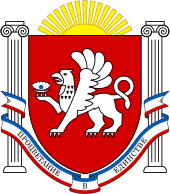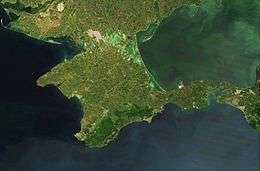Politics of Crimea
 |
| This article is part of a series on the politics and government of Crimea |
|
Republic of Crimea (within Russia)
Autonomous Republic of Crimea (within Ukraine) |
| See also |
|
Political status of Crimea Politics of Russia Politics of Ukraine |
|
|
The politics of Crimea today is that of the Republic of Crimea on one hand, and that of the federal city of Sevastopol on the other, within the context of the largely unrecognised annexation of Crimea by the Russian Federation in March 2014. While the Russian Federation both claims and administers the Republic of Crimea and the city of Sevastopol as its federal subjects, Ukraine continues to assert that Crimea is an integral part of its territory.
From 1991 until the events of 2014, the politics of Crimea had been that of the Autonomous Republic of Crimea and of Sevastopol. However, the ousting of the democratically elected Ukrainian president, Viktor Yanukovych during the 2014 Ukrainian revolution initiated a chain of events that culminated in a referendum in Crimea on whether it should rejoin Russia. Days after the official results revealed overwhelming support for the proposal, Russia signed a Treaty of Accession with the self-declared independent Republic of Crimea that annexed Crimea to the Russian Federation as two federal subjects.
Institutions
The Constitution of the Republic of Crimea is the basic law of the Republic of Crimea within the Russian Federation. It was ratified on 11 April 2014 and replaced the previous Constitution of the Autonomous Republic of Crimea that was repealed by the Crimean status referendum.[1]
While the Russian constitution was updated to list the Republic of Crimea and Sevastopol as the 84th and 85th Federal Subjects of the Russian Federation, Ukraine's constitution continues to assert that sovereignty over Crimea belongs to the Ukrainian government with the Crimean head of state being the President of Ukraine, currently Petro Poroshenko.
Parliament of Crimea
The 75-seat State Council of Crimea is the legislative branch of the Republic of Crimea. Elections are conducted under a system of mixed-member proportional representation, with 25 single-member constituencies and 50 part-list seats. At the 2014 Crimean parliamentary election, United Russia won 70 seats, including all 25 single-member constituencies, with the Liberal Democratic Party of Russia winning 5 seats.
Before 2014, the 100-seat legislative branch of the Autonomous Republic of Crimea was called the Supreme Council of Crimea. This parliament had no right of legislative initiative.[2] It was responsible for appointing the Council of Ministers. Following the decision of the Ukrainian parliament to dissolve the supreme council of Crimea in March 2014, the Supreme Council decided to rename itself as the State Council of Crimea, and to continue as the parliament of Crimea.[3]
Government of Crimea
The Head of the Republic of Crimea is the highest office holder within the Republic of Crimea. This position replaced the post of Prime Minister of Crimea which is the head of the Council of Ministers according to the Constitution of the Autonomous Republic of Crimea.
After Russia's 2014 annexation most Crimean public officials weren't replaced.[4]
Judiciary
The Judiciary is independent of the executive and the legislature branches and the responsibility of the national authorities.
In Russia, for serious and specific crimes (murder, kidnapping, rape with aggravating circumstances, child trafficking, gangsterism, large-scale bribery, treason, terrorism, public calls for violent change in the constitutional system or for the seizure of power, and select other crimes against the state), the accused have the option of a jury trial consisting of 12 jurors, who must be 25 years old, legally competent, and without a criminal record.[5] In Ukraine, "jury trials" have 2 judges and 3 jurors,[6] but there is confusion over whether or not these are jurors or lay judges.[7][8][9] Russian juries are similar to common law juries, and unlike lay judges, in that they sit separately from the judges and decide questions of fact alone while the judge determines questions of law.[10] (Russia used jury trials from 1864-1917, reintroduced the jury trial in 1993, and extended it to another 69 regions in 2003;[11] Ukraine's first "jury trial" ended in October 2013 in Sumy.[6])
Administrative divisions
The Republic of Crimea, just as the Autonomous Republic of Crimea, is subdivided into a total of 25 regions: 14 raions (districts) and 11 city municipalities. Though the City of Sevastopol is located on the Crimean peninsula, it is administratively separately from the Republic of Crimea as a federal city. The capital of the Republic of Crimea is the City of Simferopol, located in the interior of the peninsula.
Politics of Crimea today
During the 2014 Crimean Crisis, the Supreme Council of Crimea called a referendum on 16 March on whether Crimea should leave Ukraine and rejoin Russia. On achieving a clear majority for the proposal, the Crimean parliament declared independence from Ukraine and applied to be admitted to the Russian Federation. Crimea was accepted into Russia on 18 March 2014 and a new Constitution was passed by Crimea's parliament on 11 April 2014. However, Ukraine, supported by most of the international community, regards the referendum as illegal and does not recognise the declaration of independence or the annexation of Crimea by Russia. It views Crimea as 'temporarily occupied territories".
Elections and referendums
Crimean parliamentary election, 2014
The latest parliamentary elections in Crimea were held in 2014. Before the current constitution took force, Crimea had a President from 1994 to 1995. The first and only presidential elections took place in January 1994. The most recent referendum was held in 2014 concerning whether Crimea should declare independence and seek to join Russia.
Crimean parliamentary election, 2010
| Parties | Party list votes | Party list % | Swing (party list) % | Mandates won on party list | Constituencies won | Swing (in mandates) |
|---|---|---|---|---|---|---|
| Party of Regions | 357030 | 48,93% | +19,54% | 32 | 48 | +4 |
| Communist Party of Ukraine | 54172 | 7,42% | +1,15% | 5 | -4 | |
| Qurultai-Rukh | 51253 | 7,02% | +0,47% | 5 | -3 | |
| Soyuz | 38514 | 5,28% | -1,47% | 3 | 2 | -5 |
| Russian Unity | 29343 | 4,02% | 3 | |||
| Strong Ukraine | 26515 | 3,63% | 2 | |||
| People's Party | 4563 | 0,63% | ||||
| Progressive Socialist Party of Ukraine | 12614 | 1,73% | -7 | |||
| Party of Pensioners of Ukraine | 11133 | 1,53% | ||||
| Batkivschyna | 19589 | 2,68% | -3,62 | -8 | ||
| Front for Change | 8281 | 1,13% | ||||
| Svoboda | 1361 | 0,19% | ||||
| Against all Invalid ballots | 57552 | 7.89% | ||||
| Invalid ballots | 21794 | -1.43% | ||||
| Total | 997,575 | 100% | 50 | 50 |
Crimean parliamentary election, 2006
| Parties | Votes | % | Mandates |
|---|---|---|---|
| Bloc "For Yanukovych!" (Блок "За Януковича!") | 324,710 | 32.55 | 44 |
| Soyuz (Союз) | 76,143 | 7.63 | 10 |
| Electoral Bloc of Kunitsyn (Блок Куніцина) | 75,391 | 7.63 | 10 |
| Communist Party of Ukraine (Комуністична партія України) | 65,341 | 6.55 | 9 |
| Qurultai-Rukh (Курултай-Рух) | 62,448 | 6.26 | 8 |
| Yulia Tymoshenko Electoral Bloc (Блок Юлії Тимошенко) | 60,153 | 6.03 | 8 |
| People's Opposition Bloc of Natalia Vitrenko (Блок Наталії Вітренко) | 49,579 | 4.97 | 7 |
| Opposition Bloc "Ne Tak" (Опозиційний блок "НЕ ТАК!") | 30,825 | 3.09 | 4 |
| Lytvyn's People's Bloc (Народний блок Литвина) | 19,153 | 1.92 | - |
| Bloc Our Ukraine (Блок Наша Україна) | 12,369 | 1.24 | - |
| Socialist Party of Ukraine (Соціалістична партія України) | 9,576 | 0.96 | - |
| Pora! (ПОРА!) | 1,895 | 0.19 | - |
| Against all | 33,569 | 20.98 | - |
| Total | 997,575 | 100.0 | 100 |
Crimean presidential election, 1994
| Candidates — nominating parties | Votes first round | % | Votes second round | % |
|---|---|---|---|---|
| Yuriy Meshkov — Bloc "Russia" | 557,226 | 38.50 | 1,040,888 | 72.92 |
| Mykola Bahrov — (supported by Mejlis) | 254,042 | 17.55 | 333,243 | 23.35 |
| Serhiy Shuvainykov — Russian Party of Crimea | 196,324 | 13.56 | ||
| Leonid Hrach — Communist Party of Ukraine | 176,330 | 12.80 | ||
| Ivan Yermakov — Ukrainian president representative in Sevastopol | 90,347 | 6.22 | ||
| Volodymyr Verkoshansky — self-nomination | 14,205 | 0.98 | ||
| Total | 1,288,474 | 100.00 | 1,374,131 | 100.00 |
| Source: | ||||
See also
References
- ↑ "Crimean lawmakers approve new pro-Russian constitution". Jurist.org. 11 April 2014. Retrieved 15 February 2016.
- ↑ The Crimea wants to protect majority principle, Den (7 October 2003)
Crimea prepares amendments to Constitution, ForUm (21 January 2013) - ↑ Verkhovna Rada Autonomous Republic of Crimea. Rada.crimea.ua. Retrieved on 19 March 2014.
- ↑ Dreams in Isolation: Crimea 2 Years After Annexation, The Moscow Times (18 March 2016)
- ↑ Terrill, Richard J. (2009). World Criminal Justice Systems: A Survey (7 ed.). Elsevier. p. 439. ISBN 978-1-59345-612-2.
- 1 2 "First 'jury trial' in Ukraine ends with an acquittal". Kharkiv Human Rights Protection Group. 29 October 2013.
- ↑ "In Ukraine, scales of justice often imbalanced". Kyiv Post. Reuters. 9 April 2012.
- ↑ "Role of jury in Ukraine". Kyiv Post. 1 June 2011.
- ↑ "Why Ukraine still has no jury trials". Kyiv Post. 16 June 2011.
- ↑ Terrill 2009, p. 439.
- ↑ Terrill 2009, pp. 438-439.
- ↑ Regions Party gets 80 of 100 seats on Crimean parliament, Interfax Ukraine (11 November 2010)
External links
- "Council of Ministers of the ARC" (in Ukrainian). Portal "Autonomous Republic of Crimea". Retrieved 9 April 2009.
- Constitution of the Republic of Crimea
- "Constitution of the Autonomous Republic of Crimea" (in Russian). Official site of the Verkhovna Rada of Crimea. Retrieved 6 April 2009.
